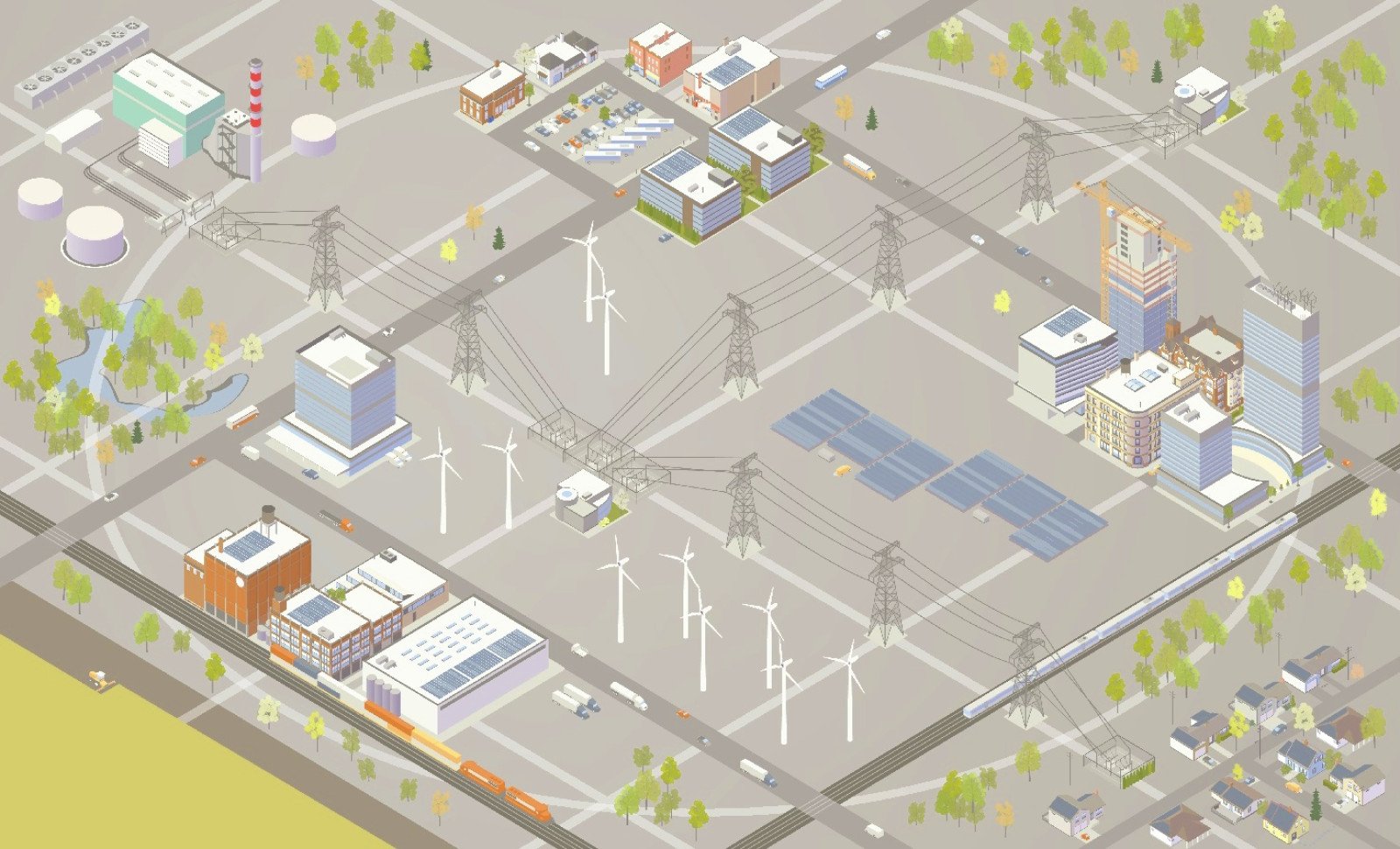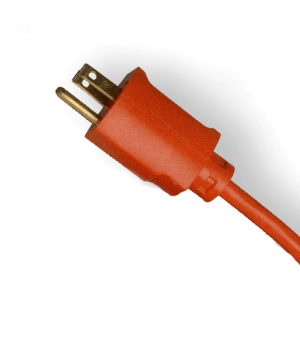Design and power a community icebreaker
Students introduce themselves by designing personalized community regions, then collaboratively connect them to a shared power grid, balancing resources to build a unified and sustainable city.

Overview
In this collaborative and creative activity, students will design their own personally themed community regions, calculate how much power their region will need, and select natural energy sources to power it. The class will then come together to connect their region to a shared classroom city grid carefully managing limited power units and connections. They’ll reflect on the challenges of energy distribution, the importance of sustainable planning, and how individual contributions shape a connected community.
Instructions
What you'll need
- Region templates – one per group of students
- Energy source printouts – a few of each printed
- String or tape for connecting regions to power sources
- Power token pieces – any item for counting quantities, will need at least 50 and up to 80. (beads, blocks, etc.)
- If no item is available, can also be tracked as a running total on the board.
- Optional token printouts included
Introduction
Have a brief discussion about what communities look like and how we power those communities with electricity:
- Discuss as a group some of the things students see in their communities, what places they love most in their communities, and what they wish they had more of in their communities.
- Ask students if they know how electricity is distributed throughout their community. Explain that the electrical grid is the system in place to generate and distribute electricity to our communities.
- Review natural energy sources: hydro, wind, solar, geothermal, and biomass. See teaching notes for definitions.
- Explain that today you will be drawing your own classroom community and exploring how you would power everything in the grid.
Region Design
Students will design their own regions in the community. As an icebreaker, students should be encouraged to share things about themselves and their interests as they draw. This could mean drawing their home, their favorite shops and restaurants, their hobbies, and references to other things they love. At the same time, they'll have to think about how much electricity those places use and how to power them.
- Split students into groups and hand out one region template per group. Give students time to work together to draw and decorate their own personal region in the community. Ensure that their regions are decorated and themed to reflect the personalities of each student in the group, while making sure to capture all the buildings and structures that they include. The regions must also have a name, and a chosen natural energy source. See teaching notes for explanation of a more detailed region example.
- Once the students have completed designing their personal regions, have them calculate the power rating of their region using the following guidelines. Choose a level based on the difficulty level you want the class to tackle:
- Level 1 (Primary grades): count how many things drawn in the region use electricity. The resulting number is the power rating.
- Level 2 (Intermediate grades): weigh the power ratings of different locations in the region and add up the total.
- Small business = power rating of 100
- Medium business = 300
- Large business = 500
- House = 1
- Level 3 (Extension): have students estimate the annual kilowatt hours (kWh) requirement of their region using the following guidelines:
- average household = 11,000 kWh
- small business = 20,000 kWh
- medium business = 60,000 kWh
- large business = 100,000 kWh
Power rating examples:
- Small businesses: small offices, local doctor or dentist’s office, local retail stores, small restaurants, fast food locations.
- Medium businesses: large restaurants, event spaces, schools, libraries, large office buildings, bigger individual retail stores.
- Large businesses: greenhouses, malls, grocery stores, hospitals, factories.
Connecting to the grid
By the end of this stage, all the regions that the class drew should be connected into a grid with each one connected to a power source, and everything added up to make sure there's enough power for everyone. The end result should be a fun collection of drawings that reflect the students in the class but also remind us how our modern lives are all connected to energy sources.
- Set up the classroom grid either on the board, the wall, a bulletin board in the hallway, or on the floor. Introduce one of each natural energy source to start. Note that each energy source has an output corresponding to the power rating guidelines above and an optional connection limit.
- Note: outputs were roughly based on the Electricity Generation by Fuel Type 2021 data from the B.C. Energy Profile, but adjusted slightly for ease of activity. If they had been accurately represented by those percentages, in the simplest case each hydro source would have contributed 45 units, solar would contribute 1, wind would contribute 2, geothermal would contribute 0, and biomass would contribute 3.
- Note: outputs were roughly based on the Electricity Generation by Fuel Type 2021 data from the B.C. Energy Profile, but adjusted slightly for ease of activity. If they had been accurately represented by those percentages, in the simplest case each hydro source would have contributed 45 units, solar would contribute 1, wind would contribute 2, geothermal would contribute 0, and biomass would contribute 3.
- Randomly select a group and have them present their region to the class by answering the following questions:
- Introduce the group members.
- What did they name their region?
- What kind of themes did they include in their region design and which group member are they representing?
- What are some of the notable places and features of the region and who chose to include them?
- What energy source did they choose to power their region and why?
- What is the power rating of their region?
- Once they’ve presented their region, which should also include introducing themselves and their interests, have them place it somewhere in the community grid and use the string or tape to connect their region to the energy generation source. Deduct their power rating total from the output total either by subtracting from the running total or physically removing power unit tokens placed on the source. If there is not enough energy generation at the source, or the source has reached it’s connection limit, build a new generation source and connect to that.
Reflection
After everyone has presented their region and connected to the grid, reflect on the experience and discuss some of the following questions as a class:
- How did their regions reflect who they are? Did they notice any similarities between their region and someone else’s?
- What challenges did we face when connecting our regions to the grid?
- Why is it important to use natural energy sources?
- What did you notice about how our choices affected others in the grid?
- Why is it important to think about the needs of the whole community when making decisions and how we can continue to do this in the classroom all year?
- How did we work together to make sure everyone had enough power and what would happen if we didn’t work together?
- How is this similar to how real cities manage electricity?
- What would you do differently if we built the grid again?
Modify or extend this activity
- For small classes or groups, you could give one region template to each individual to draw their own region and calculate their own power rating.
- Have students create an energy budget tracking template to reflect on their region’s energy usage each day and identify opportunities for energy conservation.
- Allow students to choose two energy sources to connect to. Have them designate how much of their power rating comes from each energy source. Can you perfectly balance the city?
- Introduce different parameters to consider when connecting to the grid to make it more of a challenge, such as not letting distribution lines cross each other or having to do a classroom vote when they need to build a new energy generation station in order to connect the next region.
- Introduce limits to the number of regions that can connect to a generation station and build substations to accommodate more connections (ex. The energy source can only have 2 regions directly connected, but if there is a substation built to it, then each substation can connect to 2 more regions.)
Curriculum Fit
On this tab you'll find all connections to the BC curriculum as well as our brief suggestions for assessment.
Core competencies
Communication
- Connecting and engaging with others
- Working collectively
- Supporting group interactions
- Determining common purposes
Thinking
- Creating and innovating
- Generating and incubating
- Designing and developing
- Reflecting and assessing
Personal and Social
- Recognizing personal values and choices
- Building relationships
- Contributing to community and caring for the environment
Grade 3-7 Science
Big ideas
- Living things are diverse, can be grouped, and interact with their ecosystems (Gr. 3)
- Energy can be transformed (Gr. 4)
- Machines are devices that transfer force and energy (Gr. 5)
- Earth materials change as they move through the rock cycle and can be used as natural resources (Gr. 5)
- Earth and its climate have changed over geological time (Gr. 7)
Content
- Energy is needed for life (Gr. 3)
- Sources of and transfer of thermal energy (Gr. 3)
- Energy has various forms and is conserved (Gr. 4)
- Devices that transform energy (Gr. 4)
- Power – the rate at which energy is transferred (Gr. 5)
- The nature of sustainable practices around BC’s resources (Gr. 5)
- First Peoples knowledge of sustainable practices (Gr. 5)
- Electricity is generated in different ways with different environmental impacts (Gr. 7)
Curricular competencies
Questioning and predicting
- Demonstrate curiosity about the natural world (Gr. 3-4)
Processing and analyzing data and information
- Experience and interpret the local environment (Gr. 3-7)
Evaluating
- Identify environmental implications of their and others’ actions (Gr. 3-7)
Grade 3-7 Social Studies
Big ideas
- Natural resources shape the economy, identity, and emergence of communities (Gr. 4-7)
Content
- Relationships between humans and their environment (Gr. 3)
- Physiographic features and natural resources of Canada (Gr. 4)
- Resources and economic development in different regions of Canada (Gr. 5)
- Economic policies and resource management (Gr. 6)
- Human responses to particular geographic challenges and opportunities, including climates, landforms, and natural resources (Gr. 7)
Curricular competencies
Significance
- Explain / construct arguments of why people, events, or places are significant to various individuals and groups (Gr. 3-6)
Cause and consequence
- Recognize / differentiate between causes and consequences of event, decisions, or developments (Gr. 2-6)
Assessments
- Observe student’s communication skills when presenting their region to the class, and encourage them to communicate what each element they drew means to them.
- Assess student’s accuracy in calculating the power rating of their region and problem solving skills when connecting their region to the grid.
- Encourage active listening skills when classmates are presenting.
Teaching Notes
These teaching notes contain more information on the following topics:
- Natural energy sources
- Detailed explanation of a region example
- Average business rates
- Small, medium, and large businesses
- Distribution grid in B.C
- Transmission system
Natural energy sources
Natural energy sources are types of energy that come from nature—like the sun, wind, water, and the Earth. We can use them to make electricity, heat our homes, and power things without running out or hurting the planet.
- Hydro power collects water behind a dam, then uses gravity to pull that water down large pipes called penstocks. The movement of this water then pushes against and turns a turbine, which then powers a motor and generates electricity.
- Solar power collects energy from the sun’s rays using a solar panel. This causes electrons to move, creating electrical energy that we can use to power things.
- Wind power is made when the wind spins wind turbines, which then power a motor and generate electricity.
- Geothermal energy is heat that comes from deep inside the Earth. This heat makes steam, which we can use to spin turbines, connected to motors that generate electricity.
- Biomass energy comes from things that were once alive – plants, wood, even food scraps. We burn these, or let them break down naturally, which releases heat energy, that creates steam that can be used to turn turbines, power a motor, and generate electricity.
Detailed region example
To maximize this activity as an icebreaker, encourage students to be creative in the designs of their regions.
For example, here is a description of Nicole's region:
My region is called Starfall Shores. It would be a magical beach oasis containing a castle, a pirate ship just off the coast, a beachfront café, a library, farmer’s market and small farm up on a hill, a one room schoolhouse, community center, and a fast food burger restaurant. It would be coloured in bright yellows, blues, pinks, purples, and greens, with a constant rainbow over the water. It uses solar power, and I would build solar panels up on the hills above the shores. There would be lots of palm trees, flowers, and fountains, and Disney theme park ambient music would be coming out of little rock speakers spread throughout! This region shows off a lot of my personality – my favourite places, my hobbies, my favourite colours, and my love of the beach.
The power rating for Starfall Shores, at each level, would be:
- Level 1– 7 (castle, café, library, farm, schoolhouse, community center, and restaurant using electricity. The pirate ship and farmer’s market do not use electricity)
- If including the option to select two power sources, I might say that 4 comes from solar and 3 comes from wind
- Level 2– 2101 (small: café, restaurant. Medium: library, schoolhouse, community center. Large: castle, farm, House: farmhouse)
- If including the option to select two power sources, I might say that 1101 comes from solar, and 1000 comes from wind
- Level 3- 691,000 kWh (using categorizations from Level 2 to calculate kWh)
- Note that I could also have estimated more accurately by justifying that the library might use more electricity than the schoolhouse as it has more computers and tech so I would say the library would use 70,000 and the schoolhouse at 60,000)
Average business rates
The General Service Business Rates were used when categorizing the electricity usage for student’s region power ratings. These rates are split into small, medium, and large based on a business’ peak demand as calculated over 15 minute intervals. Because these rates are calculated over 15 minute intervals, to get the related house rate we took the average annual household kWh of 11,000 kWh and calculated the average electricity usage per 15 minutes to get a rate of 0.3 kW. These numbers were then also used to estimate related weights for power ratings, using 0.3 kW as a weight of 1.
Small, medium, and large businesses
Small General Service
These are small businesses with an annual peak electricity demand of up to 35 kW. Examples include:
- Small offices (e.g., local doctor’s or dentist’s offices)
- Boutique law or engineering firms
- Family-owned retail stores
- Small-scale manufacturing operations (like a wool clothing workshop with a few employees in a single building)
- Restaurants, whether independent or part of a chain — even a local McDonald’s could fall into this category, depending on its size and energy usage.
Medium General Service
This category includes businesses with an annual peak demand between 35 kW and 150 kW. These are typically:
- Larger office spaces
- Bigger restaurants or pubs
- Small manufacturing or wholesale operations
- Greenhouses
- Schools and similar institutions
Large General Service
These are businesses with an annual peak demand greater than 150 kW, but still connected only to the distribution system (not the high-voltage transmission network). Examples include:
- Large greenhouses
- Major manufacturing facilities
- Grocery stores
- Hospitals
- Shopping malls
Transmission Customers
These are large industrial users that draw power directly from the transmission system, bypassing the distribution network entirely. Examples include:
- Mines
- Pulp mills
- Data centers
- Large-scale greenhouses
This category is useful to discuss when exploring the energy needs of potential developments in a community, after the completion of the activity. For instance, if students envision a mine or a data center in their town, these would be transmission-level customers.
Distribution grid in B.C.
BC Hydro generates power by harnessing the power of moving or falling water to produce mechanical/electrical energy. BC Hydro generates over 43,000 gigawatt hours of electricity annually to supply more than 1.6 million residential, commercial and industrial customers. This power is delivered using an interconnected system of over 73,000 kilometres of transmission and distribution lines.
So how do we generate this power? The process begins before electricity even reaches customers. The steps to generating electricity from a dam and how it is transported are outlined below.
- Hydro dam: There is potential energy stored in a water reservoir behind a dam. It is converted to kinetic energy when the water starts flowing down the penstock, from the dam. This kinetic energy is used to turn a turbine.
- Generator: The falling water strikes a series of blades attached around a shaft which converts kinetic energy to mechanical energy and causes the turbine to rotate. The shaft is attached to a generator, so that when the turbine turns, the generator is driven. The generator converts the turbine's mechanical energy into electric energy.
- Step-up transformer: Voltage is the pressure that makes electricity flow. Generators usually produce electricity with a low voltage. In order for the transmission lines to carry the electricity efficiently over long distances, the low generator voltage is increased to a higher transmission voltage by a step-up transformer.
- Grid high voltage transmission lines: Usually supported by tall metal towers, carry high voltage electricity over long distances.
- Terminal stations: Control power flow on grid transmission lines and reduce the grid voltage to sub-transmission voltage.
- Sub-transmission lines: Sub-transmission lines supply power from terminal stations to large industrial customers or distribution substations.
- Customer use: Electric energy can be sold at transmission voltage to users of large amounts who own and operate their own substations. Most customers, however, are unable to accept energy at transmission voltage, and require that it be stepped down in a transformer.
- Distribution substation: A system of transformers, meters, and control and protective devices. At a substation, transmission voltage is reduced to lower voltages for distribution to residential, commercial, and small and medium industrial customers.
Transmission system
- BC's high voltage transmission system consists of:
- Over 18,000 km of lines and underwater submarine cables
- 100,000 wood poles
- 22,000 steel towers
- 292 substations
The transmission grid in BC operates at voltages from 69 kV to 500 kV and stretches over 75,000 hectares of the province.
Most of the generation (production of electricity) comes from facilities in the northern and southern Interior of BC, while most of the load (consumption of electricity) is in the Lower Mainland and Vancouver Island.
70 - 80% of the province's electricity is consumed in the Lower Mainland and on Vancouver Island.






